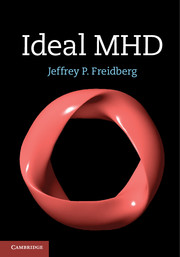Book contents
- Frontmatter
- Dedication
- Contents
- Preface
- Acknowledgements
- 1 Introduction
- 2 The ideal MHD model
- 3 General properties of ideal MHD
- 4 MHD equilibrium: general considerations
- 5 Equilibrium: one-dimensional configurations
- 6 Equilibrium: two-dimensional configurations
- 7 Equilibrium: three-dimensional configurations
- 8 MHD stability – general considerations
- 9 Alternate MHD models
- 10 MHD stability comparison theorems
- 11 Stability: one-dimensional configurations
- 12 Stability: multi-dimensional configurations
- Appendix A Heuristic derivation of the kinetic equation
- Appendix B The Braginskii transport coefficients
- Appendix C Time derivatives in moving plasmas
- Appendix D The curvature vector
- Appendix E Overlap limit of the high β and Greene–Johnson stellarator models
- Appendix F General form for q(ψ)
- Appendix G Natural boundary conditions
- Appendix H Upper and lower bounds on δQKIN
- Index
- References
11 - Stability: one-dimensional configurations
Published online by Cambridge University Press: 05 July 2014
- Frontmatter
- Dedication
- Contents
- Preface
- Acknowledgements
- 1 Introduction
- 2 The ideal MHD model
- 3 General properties of ideal MHD
- 4 MHD equilibrium: general considerations
- 5 Equilibrium: one-dimensional configurations
- 6 Equilibrium: two-dimensional configurations
- 7 Equilibrium: three-dimensional configurations
- 8 MHD stability – general considerations
- 9 Alternate MHD models
- 10 MHD stability comparison theorems
- 11 Stability: one-dimensional configurations
- 12 Stability: multi-dimensional configurations
- Appendix A Heuristic derivation of the kinetic equation
- Appendix B The Braginskii transport coefficients
- Appendix C Time derivatives in moving plasmas
- Appendix D The curvature vector
- Appendix E Overlap limit of the high β and Greene–Johnson stellarator models
- Appendix F General form for q(ψ)
- Appendix G Natural boundary conditions
- Appendix H Upper and lower bounds on δQKIN
- Index
- References
Summary
Introduction
Chapter 11 describes the MHD stability of one-dimensional cylindrical configurations, specifically the general screw pinch. The analysis involves both the Energy Principle and in some cases the normal mode eigenvalue equation. The goal is to learn about the properties of a magnetic geometry that lead to favorable or unfavorable MHD stability. Even in a cylindrical geometry a great deal of insight can be obtained regarding MHD stability, although there are important toroidal effects that are described in the next chapter.
The discussion begins with the special case of the θ-pinch. Here, a trivial application of the Energy Principle shows that the θ-pinch has inherently favorable stability properties. Also described is “continuum damping” which has many similarities to the well-known phenomenon of Landau damping of electrostatic plasma oscillations. This analysis is simplified by the introduction of the “incompressible MHD” approximation. It is shown that even though the continuum lies entirely on the real ω axis, an initial perturbation will be exponentially damped.
- Type
- Chapter
- Information
- Ideal MHD , pp. 428 - 569Publisher: Cambridge University PressPrint publication year: 2014



